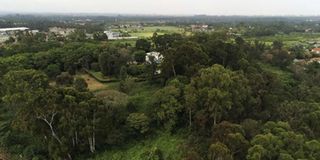Premium
How forests can help keep millions out of poverty

An aerial view of Ngong Forest as seen along Karen road.
What you need to know:
- Researchers argue that developing countries like Kenya must prioritise improving their forest cover, even as they battle to improve infrastructure such as energy producing plants, highways or ports.
- In the report, the researchers state that forests and trees are not a cure-all for poverty but are essential to the overall solution.
Developing countries like Kenya could keep millions of their people out of poverty, and essentially achieve several Sustainable Development Goals (SDGs), by simply encouraging people to plant trees.
The suggestion is in a new report compiled by various organisations involved in promoting policies that support environmental conservation in poverty alleviation, including the International Union of Forest Research Organisations (IUFRO).
Researchers in the document argue that developing countries like Kenya must prioritise improving their forest cover even as they battle to improve infrastructure such as energy production plants, highways or ports.
The scientists identified Kenya's mega infrastructure projects such as the Lamu Port Southern Sudan Ethiopia Transport Corridor (Lapsset), which aim to increase national and international connectivity and secure access to energy and natural resources, as crucial for the country's ambition to achieve the SDGs.
But they argue that policy makers must work on replenishing forests cleared to pave the way for the projects in order to make them sustainable.
The SDGs are 17 key goals created by the UN to help reduce global poverty, improve the environment, end conflicts as well as create a more connected globe.
They were a betterment of the Millennium Development Goals, criticised for being a blanket ambition for the world.
The SDGs are region-specific and each country has its own priorities but the goals should be achieved by 2030, the globally accepted deadline.
For Kenya, the challenge of improving forest cover has been to raise it from the current 7 per cent to at least 10 by 2022.
According to the Food and Agriculture Organization (FAO) of the United Nations, Kenya has about 3.4 million hectares of forest but just about 654,000 of them are considered primary forest.
A strategy published by the Kenya Forest Service (KFS) in 2018 showed it would rehabilitate the degraded forests to reach 10 per cent cover by 2022. However, that programme could cost up to Sh50 billion.
Essential component
In the report, the researchers state that forests and trees are not a cure-all for poverty but are essential to the overall solution.
With health experts predicting future pandemics due to ecological degradation and climate scientists warning that the Caribbean will experience more intense hurricanes like Maria, the report states that these challenging times call for a rethink of current poverty eradication measures.
It adds that the ability of forests and trees to positively impact lives, health and livelihoods must be a central part of discussions to lift people out of poverty, particularly in rural settings.
"Evidence shows that forests and tree-based systems can support rural livelihoods, have a buffer function in maintaining livelihoods and represent natural insurance," says the report titled 'Forests, Trees and the Eradication of Poverty: Potential and Limitations' launched online on Thursday.
But as the world battles with the Covid-19 pandemic and with 10 years left to achieve the SDGs, the new document says millions of Africans could be lifted out of poverty if governments focused more on planting trees.
The researchers, however, add a caveat to their suggestion, indicating that tree planting can lift people out of poverty only if accompanied by supportive policies.
They say this is because poverty is dynamic and often fueled by factors beyond mere access to natural wealth.
For example, Kenya was fingered for putting forest management in the hands of elites. The poor folk who could have traditional knowledge on which trees benefit them more are often left out of the programmes.
Inequality
The report states that the rural poor need forests for subsistence and income generation, but in one of its major findings, says inequality in the distribution of forest benefits continues to hurt the vulnerable.
"To illustrate, in large scale, logging on indigenous lands or where marginalised people live, timber is the most valuable forest product yet that value is often not accrued to the people who have to deal with the aftermath of not having forests anymore," said Prof Daniel C Miller, the lead researcher and chair of the IUFRO.
Globally, one out of every 10 people live in extreme poverty, defined by the World Bank as living below a dollar a day.
And according to the World Food Programme (WFP), if current trends continue, the number of hungry people will reach 840 million or one ninth of the world's population by 2030.
The report shows that some of African countries now affected by the Covid-19 pandemic also have the most people in extreme poverty in spite of having huge forest covers.
Africa has the most of the 737 million people around the world living in extreme poverty (below a dollar a day).
The DRC, Ethiopia and Nigeria have the poorest people in Africa, according to the World Bank, but the DRC, the Congo, Cameroon and neighbouring countries have the most forest cover in Africa.
Policy goals
The researchers hope the report can help inform policies on issues such as equitable and sustainable forest use and conservation.
The report was launched ahead of this year's International Day for the Eradication of Poverty, World Food Day and the International Day of Rural Women – three important days on the UN calendar that promote sustainable livelihoods, food security and poverty eradication.
It was compiled by 22 researchers from nine countries and focused on the link between forests and poverty alleviation in Africa, Asia and Latin America in the Covid-19 pandemic era.
The study was spearheaded by the IUFRO and the Collaborative Partnership on Forests (CPF) affiliated with FAO.





